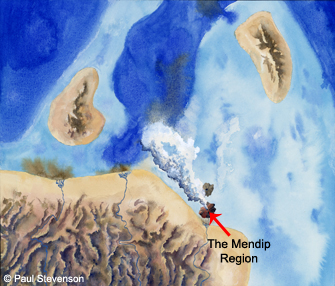
Ancient environments
Silurian l Devonian l Carboniferous l Triassic l Jurassic
The Silurian, 444 – 416 million years ago

During the Silurian the Mendip region was a volcanic island surrounded by a shallow sea. Landmasses to the north and south were converging, and the Iapetus Ocean that separated them was narrowing. At the end of the Silurian the final closure of this ocean produced mountain ranges across what is now Wales, Scotland and northern England.
The volcanic rocks that form the Silurian succession are a mixture of andesite lava flows and compacted volcanic ash (called 'tuff'). Agglomerates, comprising coarse, brecciated broken up rocks composed mainly of lava fragments, are testament to the explosive power of the eruptions. Some of the lavas have pillow-like structures ('pillow lavas') showing that they were erupted into water, but other flows have eroded and reddened tops, indicating that part of the Mendip area was exposed as land.
The shallow seas that bordered the Mendip region were rich in marine life, and parts of the Welsh borderland preserve beautiful coral reefs of Silurian age. However, the mudstones that form the oldest part of the Silurian succession in the Mendips contain a low diversity fauna of brachiopods and bivalves, suggestive of a shallow-water, near-shore environment. Proximity to land and the adverse effects of volcanic activity are possible causes for such a poorly fossiliferous marine succession. Nevertheless, the remains of the brachiopod Eocoelia angelini are a good indication that these rocks belong to the upper part of the Silurian.
In the Silurian the British Isles was just south of the Equator, with Scotland forming part of a large northern landmass that was converging with landmasses on the southern side of the Iapetus Ocean. The Mendips were a shallow marine and volcanic area just off the southern shore of Iapetus.
- Home
- Overview maps
- Locality
areas
- Cheddar Gorge
- Charterhouse
- Blackdown
- Burrington Combe
- Shipham & Rowberrow
- Crook Peak & Axbridge
- Banwell to Churchill
- Priddy
- Harptree & Smitham Hill
- Draycott & Westbury-sub-Mendip
- Wookey Hole & Ebbor Gorge
- Wells
- Great Elm & Vallis Vale
- Mells & the Wadbury Valley
- The Vobster area
- The Whatley area
- Torr Works & Asham Wood
- Beacon Hill
- Stoke St Michael & Oakhill
- Holwell & Nunney
- Shepton Mallet & Maesbury
- Gurney Slade & Emborough
- The Nettlebridge valley
- Geology
- Minerals and mines
- Quarrying
- Caves and karst
- Biodiversity
- Detailed site information
- Acknowledgements
- External links
- Search
- Site map